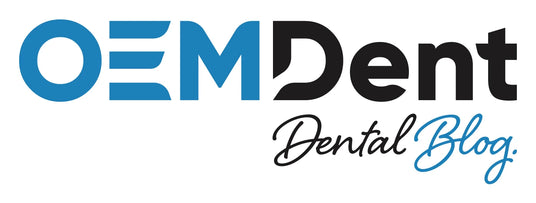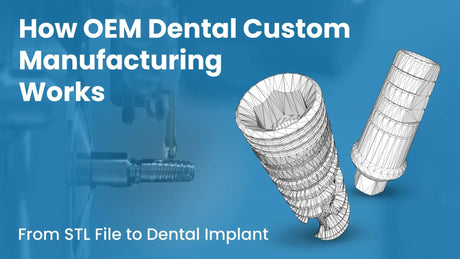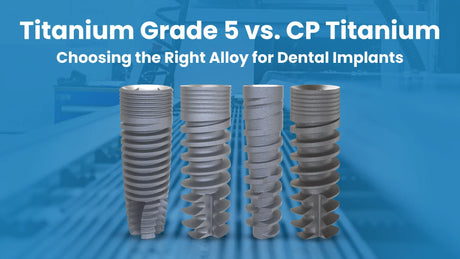

Titanium and Chrome-Cobalt: Essential Bases of UCLA Castable Abutments
In this OEMDent.com article, we delve into the world of UCLA Castable Abutments, a versatile and prominent component in dental implantology crafted by dental technicians. These abutments are extremely useful for achieving optimal prosthetic outcomes, providing a stable foundation for the attachment of dental restorations. A key factor in their effectiveness lies in the materials used to form the base of these abutments, particularly Titanium and Chrome-Cobalt. This article explores the unique properties, advantages, and specific applications of these two materials, helping readers make an informed decision when selecting their castable abutments.
UCLA Castable Abutments are known for their adaptability and precision in creating custom-fit dental restorations. These abutments, often used in both cement and screw-retained prosthetics, offer flexibility by allowing the dental technician to modify the abutment to fit the patient’s unique anatomical structure. The bases of these abutments are typically made from Titanium or Chrome-Cobalt, each bringing its own set of benefits to the table.
The Uniqueness of Plastic UCLA Castable Abutments
Plastic UCLA Castable Abutments, primarily made from burn-out plastic, also known as Polyoxymethylene (POM), offer unique advantages in dental prosthetics. These abutments are particularly favored for their ease of modification, allowing for precise shaping to fit the patient's anatomy. The burn-out plastic material is ideal for situations where a custom cast metal abutment is necessary, as it can be easily shaped and then replaced with a metal casting. Polyoxymethylene’s strength and rigidity make it suitable for ensuring that the final abutment is both durable and capable of withstanding the forces of mastication, while also providing a cost-effective solution during the initial stages of prosthetic design¹.
Titanium vs. Chrome-Cobalt: Similarities and Differences
When comparing Titanium and Chrome-Cobalt as materials for the bases of UCLA Castable Abutments, both share a commitment to biocompatibility and strength, making them reliable choices for long-term dental solutions. Titanium, specifically Titanium alloy grade 5 (Ti 6Al 4V ELI), is celebrated for its excellent strength-to-weight ratio, corrosion resistance, and general biocompatibility². This makes Titanium an excellent choice for patients who require durable and lightweight prosthetics, especially in situations where osseointegration is crucial³.
Chrome-Cobalt, on the other hand, is renowned for its superior hardness and wear resistance, making it ideal for use in situations where the prosthetic will be subjected to significant mechanical stress. Its excellent corrosion resistance also ensures longevity in the oral environment⁴. While Chrome-Cobalt is heavier than Titanium, its durability often makes it the material of choice for more robust applications, particularly in posterior regions of the mouth where higher forces are exerted during chewing⁵.
Conclusion
In this OEMDent.com article, we have explored the essential aspects of UCLA Castable Abutments, focusing on the two primary materials used in their bases: Titanium and Chrome-Cobalt. Each material offers unique advantages, from Titanium’s lightweight and biocompatible properties to Chrome-Cobalt’s durability and resistance to wear.
OEMDent.com is committed to providing a wide array of castable abutments that are compatible with the leading brands of dental implants and prosthetics, ensuring that dental professionals have the best tools available to achieve optimal patient outcomes. By understanding the specific benefits and applications of these materials, dental professionals such as dentists and dental technicians can make informed decisions, ensuring the best possible results for their prosthetic solutions.
- NIH: Fatigue Resistance of Cast-on Implant Abutment Fabricated with Three Different Alloys
- ResearchGate: Effect of Angle and Type of Customized Abutment (Castable & Cast-to) on Torque Loss and Fracture Resistance After Cyclic Loading
- MDPI: Evaluation of Behavior of Castable versus Machined Solid Abutments for Morse Tapper Implant Connection: A Clinical Retrospective Study
- ScienceDirect: The fit of cast and premachined implant abutments
- MDPI: Influence of Implant–Abutment Connection Biomechanics on Biological Response: A Literature Review on Interfaces between Implants and Abutments of Titanium and Zirconia

OEMDent.com offers uncompromised quality, cost-effective dental implants & prosthetics compatible with leading implant systems. We go beyond manufacturing, offering OEM & Private Label services to meet your dental needs.






